This site uses cookies as defined in our Cookie Policy, by continuing to use this site you agree to their use.
Continue
| Arrive | Depart | ||||||
| 21st21 | JanJan | 202525 | Fort Lauderdale, Florida, United States, embark on the Queen Victoria | ||||
| Like many southeast Florida neighbors, Fort Lauderdale has long been revitalizing. In a state where gaudy tourist zones often stand aloof from workaday downtowns, Fort Lauderdale exhibits consistency at both ends of the 2-mile Las Olas corridor. The sparkling look results from upgrades both downtown and on the beachfront. Matching the downtown's innovative arts district, cafés, and boutiques is an equally inventive beach area, with hotels, cafés, and shops facing an undeveloped shoreline, and new resort-style hotels replacing faded icons of yesteryear. Despite wariness of pretentious overdevelopment, city leaders have allowed a striking number of glittering high-rises. Nostalgic locals and frequent visitors fret over the diminishing vision of sailboats bobbing in waters near downtown; however, Fort Lauderdale remains the yachting capital of the world, and the water toys don’t seem to be going anywhere. | |||||||
| 22nd22 | JanJan | 202525 | At Sea | ||||
| 23rd23 | JanJan | 202525 | Grand Turk Island, Turks and Caicos Islands | Morning | Afternoon | ||
| Just 7 miles (11 km) long and a little more than 1 mile (1½ km) wide, this island, the capital and seat of the Turks and Caicos government, has been a longtime favorite destination for divers eager to explore the 7,000-foot-deep pristine coral walls that drop down only 300 yards out to sea. On shore, the tiny, quiet island is home to white-sand beaches, the National Museum, and a small population of wild horses and donkeys, which leisurely meander past the white-walled courtyards, pretty churches, and bougainvillea-covered colonial inns on their daily commute into town. But things aren't entirely sleepy: a cruise-ship complex at the southern end of the island brings about 600,000 visitors per year. That said, the dock is self-contained and is about 3 miles (5 km) from the tranquil, small hotels of Cockburn Town, Pillory Beach, and the Ridge and far from most of the western-shore dive sites. Pristine beaches with vistas of turquoise waters, small local settlements, historic ruins, and native flora and fauna are among the sights on Grand Turk. Fewer than 4,000 people live on this 7½-square-mile (19-square-km) island, and it's hard to get lost, as there aren't many roads. | |||||||
| 24th24 | JanJan | 202525 | At Sea | ||||
| 25th25 | JanJan | 202525 | At Sea | ||||
| 26th26 | JanJan | 202525 | Bridgetown, Barbados | Early Morning | Afternoon | ||
| Located beside the island’s only natural harbour, the capital of Barbados combines modern and colonial architecture with glorious palm tree-lined beaches and a number of historical attractions. Experience the relaxed culture of the city renowned for its British-style parliament buildings and vibrant beach life, and seek out the Anglican church and the 19th-century Barbados Garrison. The distance between the ship and your tour vehicle may vary. This distance is not included in the excursion grades. | |||||||
| 27th27 | JanJan | 202525 | At Sea | ||||
| 28th28 | JanJan | 202525 | At Sea | ||||
| 29th29 | JanJan | 202525 | At Sea | ||||
| 30th30 | JanJan | 202525 | Fortaleza, Brazil | Early Morning | Afternoon | ||
| Called the "City of Light," Fortaleza claims that the sun shines on it 2,800 hours a year. And it's a good thing, too, as the coastline stretches far beyond the city. To the east, along the Litoral Leste or the Costa Sol Nascente (Sunrise Coast) are many fishing villages. To the west, along the Litoral Oeste or the Costa Sol Poente (Sunset Coast), there are pristine stretches of sand. The shores here are cooled by constant breezes and lapped by waters with an average temperature of 24°C (72°F).Today Fortaleza, a large, modern state capital with more than 2 million inhabitants, is Brazil's fifth-largest city. It's also on the move, with one of the country's newest airports, a modern convention center, a huge cultural center with a planetarium, large shopping malls, several museums and theaters, and an abundance of sophisticated restaurants. At Praia de Iracema there's a revitalized beachfront area of sidewalk cafés, bars, and dance clubs. But if you wander along the shore, you're still bound to encounter fishermen unloading their catch from traditional jangadas—just as they've done for hundreds of years. | |||||||
| 31st31 | JanJan | 202525 | At Sea | ||||
| 1st01 | FebFeb | 202525 | At Sea | ||||
| 2nd02 | FebFeb | 202525 | Salvador de Bahia, Brazil | Early Morning | Afternoon | ||
| According to Salvador's adopted son Jorge Amado, "In Salvador, magic becomes part of the every-day." From the shimmering golden light of sunset over the Baía do Todos os Santos, to the rhythmic beats that race along the streets, Salvador, while no longer Brazil's capital, remains one of its most captivating cities. A large dose of its exoticism comes down to its African heritage—at least 70% of its 2,675,000 population is classified as Afro-Brazilian—and how it has blended into Brazil's different strands, from the native Indians to the Christian colonizers. Salvadorans may tell you that you can visit a different church every day of the year, which is almost true—the city has about 300. Churches whose interiors are covered with gold leaf were financed by the riches of the Portuguese colonial era, when slaves masked their traditional religious beliefs under a thin Catholic veneer. And partly thanks to modern-day acceptance of those beliefs, Salvador has become the fount of Candomblé, a religion based on personal dialogue with the orixás, a family of African deities closely linked to nature and the Catholic saints. The influence of Salvador's African heritage on Brazilian music has also turned the city into one of the musical capitals of Brazil, resulting in a myriad of venues to enjoy live music across the city, along with international acclaim for exponents like Gilberto Gil, Caetano Veloso, and Daniela Mercury. Salvador's economy today is focused on telecommunications and tourism. The still-prevalent African culture draws many tourists—this is the best place in Brazil to hear African music, learn or watch African dance, and see capoeira, a martial art developed by slaves. In the district of Pelourinho, many colorful 18th- and 19th-century houses remain, part of the reason why this is the center of the tourist trade. Salvador sprawls across a peninsula surrounded by the Baía de Todos os Santos on one side and the Atlantic Ocean on the other. The city has about 50 km (31 miles) of coastline. The original city, referred to as the Centro Histórica (Historical Center), is divided into the Cidade Alta (Upper City), also called Pelourinho, and Cidade Baixa (Lower City). The Cidade Baixa is a commercial area—known as Comércio—that runs along the port and is the site of Salvador's indoor market, Mercado Modelo. You can move between the upper and lower cities on foot, via the landmark Elevador Lacerda, behind the market, or on the Plano Inclinado, a funicular lift, which connects Rua Guindaste dos Padres on Comércio with the alley behind Cathedral Basílica. From the Cidade Histórica you can travel north along the bay to the hilltop Igreja de Nosso Senhor do Bonfim. You can also head south to the point, guarded by the Forte Santo Antônio da Barra, where the bay waters meet those of the Atlantic. This area on Salvador's southern tip is home to the trendy neighborhoods of Barra, Ondina, and Rio Vermelho, with many museums, theaters, shops, and restaurants. Beaches along the Atlantic coast and north of Forte Santo Antônio da Barra are among the city's cleanest. Many are illuminated at night and have bars and restaurants that stay open late. | |||||||
| 3rd03 | FebFeb | 202525 | At Sea | ||||
| 4th04 | FebFeb | 202525 | Buzios, Brazil | Early Morning | Early Evening | ||
| Around two hours from Rio de Janeiro, Búzios is a string of beautiful beaches on an 8-km-long (5-mile-long) peninsula. It was the quintessential sleepy fishing village until the 1960s, when the French actress Brigitte Bardot holidayed here to escape the paparazzi and the place almost instantly transformed into a vacation sensation. Búzios has something for everyone. Some hotels cater specifically to families and provide plenty of activities and around-the-clock child care. Many have spa facilities, and some specialize in weeklong retreats. For outdoor enthusiasts, Búzios offers surfing, windsurfing, kitesurfing, diving, hiking, and mountain biking, as well as leisurely rounds of golf. | |||||||
| 5th05 | FebFeb | 202525 | Rio de Janeiro, Brazil | Early Morning | |||
| Welcome to the Cidade Maravilhosa, or the Marvelous City, as Rio is known in Brazil. Synonymous with the girl from Ipanema, the dramatic views from Christ the Redeemer atop Corcovado mountain, and fabulously flamboyant Carnival celebrations, Rio is a city of stunning architecture, abundant museums, and marvelous food. Rio is also home to 23 beaches, an almost continuous 73-km (45-mile) ribbon of sand.As you leave the airport and head to Rio's beautiful Zona Sul (the touristic South Zone), you'll drive for about 40 minutes on a highway from where you'll begin to get a sense of the dramatic contrast between beautiful landscape and devastating poverty. In this teeming metropolis of 12 million people (6.2 million of whom live in Rio proper), the very rich and the very poor live in uneasy proximity. You'll drive past seemingly endless cinder-block favela, but by the time you reach Copacabana's breezy, sunny Avenida Atlântica—flanked on one side by white beach and azure sea and on the other by condominiums and hotels—your heart will leap with expectation as you begin to recognize the postcard-famous sights. Now you're truly in Rio, where cariocas (Rio residents) and tourists live life to its fullest.Enthusiasm is contagious in Rio. Prepare to have your senses engaged and your inhibitions untied. Rio seduces with a host of images: the joyous bustle of vendors at Sunday's Feira Hippie (Hippie Fair); the tipsy babble at sidewalk cafés as patrons sip their last glass of icy beer under the stars; the blanket of lights beneath the Pão de Açúcar (Sugarloaf Mountain); the bikers, joggers, strollers, and power walkers who parade along the beach each morning. Borrow the carioca spirit for your stay; you may find yourself reluctant to give it back. | |||||||
| 6th06 | FebFeb | 202525 | Rio de Janeiro, Brazil | Afternoon | |||
| Welcome to the Cidade Maravilhosa, or the Marvelous City, as Rio is known in Brazil. Synonymous with the girl from Ipanema, the dramatic views from Christ the Redeemer atop Corcovado mountain, and fabulously flamboyant Carnival celebrations, Rio is a city of stunning architecture, abundant museums, and marvelous food. Rio is also home to 23 beaches, an almost continuous 73-km (45-mile) ribbon of sand.As you leave the airport and head to Rio's beautiful Zona Sul (the touristic South Zone), you'll drive for about 40 minutes on a highway from where you'll begin to get a sense of the dramatic contrast between beautiful landscape and devastating poverty. In this teeming metropolis of 12 million people (6.2 million of whom live in Rio proper), the very rich and the very poor live in uneasy proximity. You'll drive past seemingly endless cinder-block favela, but by the time you reach Copacabana's breezy, sunny Avenida Atlântica—flanked on one side by white beach and azure sea and on the other by condominiums and hotels—your heart will leap with expectation as you begin to recognize the postcard-famous sights. Now you're truly in Rio, where cariocas (Rio residents) and tourists live life to its fullest.Enthusiasm is contagious in Rio. Prepare to have your senses engaged and your inhibitions untied. Rio seduces with a host of images: the joyous bustle of vendors at Sunday's Feira Hippie (Hippie Fair); the tipsy babble at sidewalk cafés as patrons sip their last glass of icy beer under the stars; the blanket of lights beneath the Pão de Açúcar (Sugarloaf Mountain); the bikers, joggers, strollers, and power walkers who parade along the beach each morning. Borrow the carioca spirit for your stay; you may find yourself reluctant to give it back. | |||||||
| 7th07 | FebFeb | 202525 | At Sea | ||||
| 8th08 | FebFeb | 202525 | At Sea | ||||
| 9th09 | FebFeb | 202525 | Montevideo, Uruguay | Morning | Afternoon | ||
| Uruguay’s capital city hugs the eastern bank of the Río de la Plata. A massive coastal promenade (malecón) that passes fine beaches, restaurants, and numerous parks recalls the sunny sophistications of the Mediterranean and is always dotted with Montevideans strolling, exercising, and lounging along the water. Montevideo has its share of glitzy shopping avenues and modern office buildings, balanced with its historic old city and sumptuous colonial architecture, as well as numerous leafy plazas and parks. It is hard not to draw comparisons to its sister city Buenos Aires across the river, and indeed Montevideo strikes many as a calmer, more manageable incarnation of Argentina's capital.When the weather's good, La Rambla, a 22-km (14-mile) waterfront avenue that links the Old City with the eastern suburbs and changes names about a dozen times, gets packed with fishermen, ice-cream vendors, and joggers. Around sunset, volleyball and soccer games wind down as couples begin to appear for evening strolls. Polls consistently rate Montevideo as having the highest quality of life of any city in Latin America. After one visit here, especially on a lovely summer evening, you probably will agree. | |||||||
| 10th10 | FebFeb | 202525 | Buenos Aires, Argentina | Early Morning | |||
| Glamorous and gritty, Buenos Aires is two cities in one. What makes Argentina's capital so fascinating is its dual heritage—part European, part Latin American. Plaza de Mayo resembles a grand square in Madrid, and the ornate Teatro Colón would not be out of place in Vienna. But you’ll know you’re in South America by the leather shoes for sale on cobbled streets and impromptu parades of triumphant soccer fans. Limited-production wines, juicy steaks, and ice cream in countless flavors are among the old-world imports the city has perfected. | |||||||
| 11th11 | FebFeb | 202525 | Buenos Aires, Argentina | Early Evening | |||
| Glamorous and gritty, Buenos Aires is two cities in one. What makes Argentina's capital so fascinating is its dual heritage—part European, part Latin American. Plaza de Mayo resembles a grand square in Madrid, and the ornate Teatro Colón would not be out of place in Vienna. But you’ll know you’re in South America by the leather shoes for sale on cobbled streets and impromptu parades of triumphant soccer fans. Limited-production wines, juicy steaks, and ice cream in countless flavors are among the old-world imports the city has perfected. | |||||||
| 12th12 | FebFeb | 202525 | At Sea | ||||
| 13th13 | FebFeb | 202525 | At Sea | ||||
| 14th14 | FebFeb | 202525 | Puerto Madryn, Argentina | Early Morning | Early Evening | ||
| Approaching from Ruta 3, it's hard to believe that the horizon line of buildings perched just beyond the windswept dunes and badlands is the most successful of all coastal Patagonia settlements. But once you get past the outskirts of town and onto the wide coastal road known as the Rambla, the picture begins to change. Ranged along the clear and tranquil Golfo Nuevo are restaurants, cafés, dive shops, and hotels, all busy—but not yet overcrowded—with tourists from around the world.Puerto Madryn is more a base for visiting nearby wildlife-watching sites like Península Valdés and Punta Tombo than a destination in its own right. The town's architecture is unremarkable, and beyond a walk along the coast there isn't much to do. Indeed, even the few museums serve mainly to introduce you to the fauna you'll see elsewhere. The exception is the beginning of whale season (May through July), when the huge animals cavort right in the bay before heading north—you can even walk out alongside them on the pier. During these months it's worth the extra expense for a room with a sea view.The many tour agencies and rental-car companies here make excursion planning easy. Aim to spend most of your time here on one- or two-day trips exploring the surroundings. Note that competition is fierce between tourism operators in destinations such as Puerto Madryn and Puerto Pirámides on Península Valdés. Take information that tour operators and even the tourism office give you about these with a grain of salt: they often exaggerate Madryn's virtues and other areas' flaws. | |||||||
| 15th15 | FebFeb | 202525 | At Sea | ||||
| 16th16 | FebFeb | 202525 | At Sea | ||||
| 17th17 | FebFeb | 202525 | Ushuaia, Argentina | Early Morning | Afternoon | ||
| At 55 degrees latitude south, Ushuaia (pronounced oo-swy-ah) is closer to the South Pole than to Argentina's northern border with Bolivia. It is the capital and tourism base for Tierra del Fuego, the island at the southernmost tip of Argentina.Although its stark physical beauty is striking, Tierra del Fuego's historical allure is based more on its mythical past than on rugged reality. The island was inhabited for 6,000 years by Yámana, Haush, Selk'nam, and Alakaluf Indians. But in 1902 Argentina, eager to populate Patagonia to bolster its territorial claims, moved to initiate an Ushuaian penal colony, establishing the permanent settlement of its most southern territories and, by implication, everything in between.When the prison closed in 1947, Ushuaia had a population of about 3,000, made up mainly of former inmates and prison staff. Today the Indians of Darwin's "missing link" theory are long gone—wiped out by diseases brought by settlers and by indifference to their plight—and the 60,000 residents of Ushuaia are hitching their star to tourism.The city rightly (if perhaps too loudly) promotes itself as the southernmost city in the world (Puerto Williams, a few miles south on the Chilean side of the Beagle Channel, is a small town). You can make your way to the tourism office to get your clichéd, but oh-so-necessary, "Southernmost City in the World" passport stamp. Ushuaia feels like a frontier boomtown, at heart still a rugged, weather-beaten fishing village, but exhibiting the frayed edges of a city that quadrupled in size in the '70s and '80s and just keeps growing. Unpaved portions of Ruta 3, the last stretch of the Pan-American Highway, which connects Alaska to Tierra del Fuego, are finally being paved. The summer months (December through March) draw more than 120,000 visitors, and dozens of cruise ships. The city is trying to extend those visits with events like March's Marathon at the End of the World and by increasing the gamut of winter activities buoyed by the excellent snow conditions.A terrific trail winds through the town up to the Martial Glacier, where a ski lift can help cut down a steep kilometer of your journey. The chaotic and contradictory urban landscape includes a handful of luxury hotels amid the concrete of public housing projects. Scores of "sled houses" (wooden shacks) sit precariously on upright piers, ready for speedy displacement to a different site. But there are also many small, picturesque homes with tiny, carefully tended gardens. Many of the newer homes are built in a Swiss-chalet style, reinforcing the idea that this is a town into which tourism has breathed new life. At the same time, the weather-worn pastel colors that dominate the town's landscape remind you that Ushuaia was once just a tiny fishing village, snuggled at the end of the Earth.As you stand on the banks of the Canal Beagle (Beagle Channel) near Ushuaia, the spirit of the farthest corner of the world takes hold. What stands out is the light: at sundown the landscape is cast in a subdued, sensual tone; everything feels closer, softer, and more human in dimension despite the vastness of the setting. The snowcapped mountains reflect the setting sun back onto a stream rolling into the channel, as nearby peaks echo their image—on a windless day—in the still waters.Above the city rise the last mountains of the Andean Cordillera, and just south and west of Ushuaia they finally vanish into the often-stormy sea. Snow whitens the peaks well into summer. Nature is the principal attraction here, with trekking, fishing, horseback riding, wildlife spotting, and sailing among the most rewarding activities, especially in the Parque Nacional Tierra del Fuego (Tierra del Fuego National Park). | |||||||
| 18th18 | FebFeb | 202525 | Cape Horn, Chile | Early Morning | Morning | ||
| 19th19 | FebFeb | 202525 | Punta Arenas, Chile | Early Morning | Early Evening | ||
| Impenetrable forests, impassable mountains, and endless fields of ice define Chilean Patagonia, and meant that the region went largely unexplored until the beginning of the 20th century. Located in the southernmost part of the country, this area is still sparsely inhabited, though you will find a few populated places—like the colorful provincial city of Punta Arenas, which looks like it's about to be swept into the Strait of Magellan. Some unique wildlife, particularly colonies of elephant seals and penguins, call this breathtaking topography home. To the north is Parque Nacional Torres del Paine, the country's most magnificent natural wonder, and whose snow-covered peaks seem to rise vertically from the plains below. The vistas, such as the fantastic Avenue of the Glaciers, are breathtaking; along this stretch of the Beagle Channel, you can pass six tremendous glaciers all within a stone's throw of each other.Cruise SightsPunta Arenas. Founded a little more than 150 years ago, Punta Arenas (Sandy Point) was Chile's first permanent settlement in Patagonia. Plaza Muñoz Gamero, the central square, is surrounded by evidence of that early prosperity: buildings whose then-opulent brick exteriors recall a time when this was one of Chile's wealthiest cities. The newer houses here have colorful tin roofs, best appreciated when seen from a high vantage point such as the Mirador Cerro la Cruz. Although the city as a whole may not be particularly attractive, look for details: the pink-and-white house on a corner, the bay window full of potted plants, parking attendants wearing the regional blue and yellow colors, and schoolchildren in identical naval pea coats that remind you that the city's fate is tied to the sea.The Museo Naval y Marítimo extols Chile's high-seas prowess, particularly concerning Antarctica. Its exhibits are worth a visit for anyone with an interest in ships and sailing, merchant and military alike. Part of the second floor is designed like the interior of a ship, including a map and radio room. Pedro Montt 989. Admission charged.Housed in what was once the mansion of the powerful Braun-Menéndez family, the Museo Regional de Magallanes is an intriguing glimpse into the daily life of a wealthy provincial family at the beginning of the 20th century. Lavish Carrara marble hearths, English bath fixtures, and cordovan leather walls are among the original accoutrements. The museum also has an excellent group of displays depicting Punta Arenas's past, from the first European contact to the town's decline after the opening of the Panama Canal. The museum is half a block north of the main square. Magallanes 949. Admission charged.The resplendent 1895 Palacio Sara Braun is a national landmark and an architectural showpiece of southern Patagonia. Designed by a French architect, the house was built from materials and by craftsmen imported from Europe during the four years of construction. The city's central plaza and surrounding buildings soon followed, ushering in the region's golden era. Noteworthy are the lavish bedrooms, magnificent parquet floors, marble fireplaces, and hand-painted ceilings. Don't miss the portraits of Braun and her husband José Nogueira in the music room. Afterwards, head to the cellar for a drink or snack in the warm public tavern (a good portion of the mansion is leased to a hotel). Plaza Muñoz Gamero 716. Admission charged.Commonly referred to simply as "El Salesiano," the Museo Salesiano de Maggiorino Borgatello is operated by Italian missionaries whose order arrived in Punta Arenas in the 19th century. The Salesians, most of whom spoke no Spanish, proved to be daring explorers. Traveling throughout the region, they collected the artifacts made by indigenous tribes that are currently on display. Av. Bulnes 398. Admission charged.Isla Magdalena. Punta Arenas is the launching point for a boat trip to the Isla Magdalena to see the more than 100,000 Magellanic penguins at the Monumento Natural Los Pingúinos. A single trail, marked off by rope, is accessible to humans. The boat trip to the island, in the middle of the Estrecho de Magallanes, takes about two hours. Make sure to bring along warm clothing, even in summer; the island can be chilly, particularly if a breeze is blowing across the water.Parque Nacional Torres del Paine. Some 12 million years ago, lava flows pushed up through the thick sedimentary crust that covered the southwestern coast of South America, cooling to form a granite mass. Glaciers then swept through the region, grinding away all but the ash-gray spires that rise over the landscape of one of the world's most beautiful natural phenomena, now the Parque Nacional Torres del Paine (established in 1959). Snow formations dazzle along every turn of road, and the sunset views are spectacular.Among the 2,420-square-km (934-square-mi) park's most beautiful attractions are its lakes of turquoise, aquamarine, and emerald green waters. Another draw is its unusual wildlife. Creatures like the guanaco (a woollier version of the llama) and the ñandú (resembling a small ostrich) abound. They are used to visitors and don't seem to be bothered by the proximity of automobile traffic and the snapping of cameras. Predators, like the gray fox, make less frequent appearances. You may also spot the dramatic aerobatics of a falcon and the graceful soaring of the endangered condor. The beautiful puma is especially elusive, but sightings have become more common. Admission charged.Pingúinera de Seno Otway. The road to this penguin sanctuary begins 30 km (18 mi) north of Punta Arenas. Magellanic penguins, which live up to 20 years in the wild, return to their birthplace here every year to mate with the same partner. For about 2,000 penguin couples—no single penguins make the trip—home is this desolate and windswept land off the Otway Sound. In late September, the penguins begin to arrive from the southern coast of Brazil and the Falkland Islands. They mate and lay their eggs in early October, and brood their eggs in November. Offspring hatch between mid-November and early December. If you're lucky, you may catch sight of one of the downy gray chicks that stick their heads out of the burrows when their parents return to feed them. Otherwise you might see scores of the ungainly adult penguins waddling to the ocean from their nesting burrows. They swim for food every eight hours and dive up to 100 feet deep. The penguins depart from the sound in late March. Note that the sanctuary is a 1-km (1/2-mi) walk from the parking lot. It gets chilly, so bring a windbreaker. Admission charged.Reserva Nacional Laguna Parillar. This 47,000-acre reserve lies west of Puerto Hambre, a tranquil fishing village, and is centered around a shimmering lake in a valley flanked by hills. It's a great place for a picnic, and there are a number of well-marked paths that offer sweeping vistas over the Estrecho de Magallanes. About 2 km (1 mi) west of Puerto Hambre is a small white monolith that marks the geographical center of Chile, the midway point between Chile's northern port Arica and the South Pole.Cruise ShoppingWool may no longer be king of the economy, but vast flocks of sheep still yield a high-quality product that is woven into the clothing here. Leather products are also common, but the prices are not necessarily low. About 3 km (2 mi) north of Punta Arenas is the Zona Franca (Av. Bulnes). This duty-free zone is where people from all around the region come for low-priced electronics and other consumer items. | |||||||
| 20th20 | FebFeb | 202525 | At Sea | Afternoon | Early Evening | ||
| 21st21 | FebFeb | 202525 | PIO X Glacier, Chile | Early Morning | Morning | ||
| 22nd22 | FebFeb | 202525 | At Sea | ||||
| 23rd23 | FebFeb | 202525 | Puerto Montt, Chile | Early Morning | Afternoon | ||
| For most of its history, windy Puerto Montt was the end of the line for just about everyone traveling in the Lake District. Now the Carretera Austral carries on southward, but for all intents and purposes Puerto Montt remains the region's last significant outpost, a provincial city that is the hub of local fishing, textile, and tourist activity.Today the city center is full of malls, condos, and office towers—it's the fastest-growing city in Chile—but away from downtown, Puerto Montt consists mainly of low clapboard houses perched above its bay, the Seno de Reloncaví. If it's a sunny day, head east to Playa Pelluco or one of the city's other beaches. If you're more interested in exploring the countryside, drive along the shore for a good view of the surrounding hills. | |||||||
| 24th24 | FebFeb | 202525 | At Sea | ||||
| 25th25 | FebFeb | 202525 | San Antonio, Chile | Early Morning | Early Evening | ||
| 26th26 | FebFeb | 202525 | Coquimbo, Chile | Morning | Early Evening | ||
| The name Coquimbo is derived from a native Diaguita word meaning 'place of calm waters'. In fact, Charles Darwin had noted that the town was 'remarkable for nothing but its extreme quietness'. Since then, Coquimbo has developed into a bustling port and the region's major commercial and industrial centre from which minerals, fish products and fruits are exported. Used during the colonial period as a port for La Serena, Coquimbo attracted attention from English pirates, including Sir Francis Drake, who visited in 1578. Visitors enjoy strolling around the town, admiring some of the elaborate woodwork handcrafted on buildings by early British and American settlers. These wooden buildings are among Chile's most interesting historical structures. Out of town, the area offers some fine beaches in a desert-like setting. Coquimbo serves as a gateway to the popular resort town of La Serena and trips farther into the Elqui Valley, known as the production centre for Chile's national drink, pisco sour. The valley is also home to several international observatories that take advantage of the region's exceptional atmospheric conditions. | |||||||
| 27th27 | FebFeb | 202525 | At Sea | ||||
| 28th28 | FebFeb | 202525 | Arica, Chile | Early Morning | Afternoon | ||
| Arica boasts that it is "the land of the eternal spring," but its temperate climate and beaches are not the only reason to visit this small city. Relax for an hour or two on the Plaza 21 de Mayo. Walk to the pier and watch the pelicans and sea lions trail the fishing boats as the afternoon's catch comes in. Walk to the top of the Morro and imagine battles of days gone by, or wonder at the magnitude of modern shipping as Chilean goods leave the port below by container ship.Arica is gaining notice for its great surfing conditions, and in 2009 hosted the Rusty Arica Pro Surf Challenge, a qualifying event to the world series of surf. | |||||||
| 1st01 | MarMar | 202525 | At Sea | ||||
| 2nd02 | MarMar | 202525 | Callao, Peru | Early Morning | |||
| When people discuss great South American cities, Lima is often overlooked. But Peru's capital can hold its own against its neighbors. It has an oceanfront setting, colonial-era splendor, sophisticated dining, and nonstop nightlife.It's true that the city—clogged with traffic and choked with fumes—doesn't make a good first impression, especially since the airport is in an industrial neighborhood. But wander around the regal edifices surrounding the Plaza de Armas, among the gnarled olive trees of San Isidro's Parque El Olivar, or along the winding lanes in the coastal community of Barranco, and you'll find yourself charmed.In 1535 Francisco Pizarro found the perfect place for the capital of Spain's colonial empire. On a natural port, the so-called Ciudad de los Reyes (City of Kings) allowed Spain to ship home all the gold the conquistador plundered from the Inca. Lima served as the capital of Spain's South American empire for 300 years, and it's safe to say that no other colonial city enjoyed such power and prestige during this period.When Peru declared its independence from Spain in 1821, the declaration was read in the square that Pizarro had so carefully designed. Many of the colonial-era buildings around the Plaza de Armas are standing today. Walk a few blocks in any direction for churches and elegant houses that reveal just how wealthy this city once was. But the poor state of most buildings attests to the fact that the country's wealthy families have moved to neighborhoods to the south over the past century.The walls that surrounded the city were demolished in 1870, making way for unprecedented growth. A former hacienda became the graceful residential neighborhood of San Isidro. In the early 1920s the construction of tree-lined Avenida Arequipa heralded the development of neighborhoods such as bustling Miraflores and bohemian Barranco.Almost a third of the country's population of 29 million lives in the metropolitan area, many of them in relatively poor conos: newer neighborhoods on the outskirts of the city. Most residents of those neighborhoods moved there from mountain villages during the political violence and poverty that marked the 1980s and ’90s, when crime increased dramatically. During the past decade the country has enjoyed peace and steady economic growth, which have been accompanied by many improvements and refurbishment in the city. Residents who used to steer clear of the historic center now stroll along its streets. And many travelers who once would have avoided the city altogether now plan to spend a day here and end up staying two or three. | |||||||
| 3rd03 | MarMar | 202525 | Callao, Peru | Early Evening | |||
| When people discuss great South American cities, Lima is often overlooked. But Peru's capital can hold its own against its neighbors. It has an oceanfront setting, colonial-era splendor, sophisticated dining, and nonstop nightlife.It's true that the city—clogged with traffic and choked with fumes—doesn't make a good first impression, especially since the airport is in an industrial neighborhood. But wander around the regal edifices surrounding the Plaza de Armas, among the gnarled olive trees of San Isidro's Parque El Olivar, or along the winding lanes in the coastal community of Barranco, and you'll find yourself charmed.In 1535 Francisco Pizarro found the perfect place for the capital of Spain's colonial empire. On a natural port, the so-called Ciudad de los Reyes (City of Kings) allowed Spain to ship home all the gold the conquistador plundered from the Inca. Lima served as the capital of Spain's South American empire for 300 years, and it's safe to say that no other colonial city enjoyed such power and prestige during this period.When Peru declared its independence from Spain in 1821, the declaration was read in the square that Pizarro had so carefully designed. Many of the colonial-era buildings around the Plaza de Armas are standing today. Walk a few blocks in any direction for churches and elegant houses that reveal just how wealthy this city once was. But the poor state of most buildings attests to the fact that the country's wealthy families have moved to neighborhoods to the south over the past century.The walls that surrounded the city were demolished in 1870, making way for unprecedented growth. A former hacienda became the graceful residential neighborhood of San Isidro. In the early 1920s the construction of tree-lined Avenida Arequipa heralded the development of neighborhoods such as bustling Miraflores and bohemian Barranco.Almost a third of the country's population of 29 million lives in the metropolitan area, many of them in relatively poor conos: newer neighborhoods on the outskirts of the city. Most residents of those neighborhoods moved there from mountain villages during the political violence and poverty that marked the 1980s and ’90s, when crime increased dramatically. During the past decade the country has enjoyed peace and steady economic growth, which have been accompanied by many improvements and refurbishment in the city. Residents who used to steer clear of the historic center now stroll along its streets. And many travelers who once would have avoided the city altogether now plan to spend a day here and end up staying two or three. | |||||||
| 4th04 | MarMar | 202525 | At Sea | ||||
| 5th05 | MarMar | 202525 | At Sea | ||||
| 6th06 | MarMar | 202525 | Manta, Ecuador | Early Morning | Early Evening | ||
| 7th07 | MarMar | 202525 | At Sea | ||||
| 8th08 | MarMar | 202525 | At Sea | Early Morning | Afternoon | ||
| 9th09 | MarMar | 202525 | At Sea | ||||
| 10th10 | MarMar | 202525 | Aruba, Aruba | Early Morning | Afternoon | ||
| 11th11 | MarMar | 202525 | At Sea | ||||
| 12th12 | MarMar | 202525 | At Sea | ||||
| 13th13 | MarMar | 202525 | Nassau, Bahamas | Early Morning | Afternoon | ||
| Nassau's sheltered harbor bustles with cruise-ship activity, while a block away Bay Street's sidewalks are crowded with shoppers who duck into air-conditioned boutiques and relax on benches in the shade of mahogany and lignum vitae trees. Shops angle for tourist dollars with fine imported goods at duty-free prices, yet you'll find a handful of stores overflowing with authentic Bahamian crafts, food supplies, and other delights. With a revitalization of downtown ongoing—the revamped British Colonial Hilton leading the way—Nassau is recapturing some of its past glamour. Nevertheless, modern influences are completely apparent: fancy restaurants, suave clubs, and trendy coffeehouses have popped up everywhere. These changes have come partly in response to the growing number of upper-crust crowds that now supplement the spring breakers and cruise passengers who have traditionally flocked to Nassau. Of course, you can still find a wild club or a rowdy bar, but you can also sip cappuccino while viewing contemporary Bahamian art or dine by candlelight beneath prints of old Nassau, serenaded by soft, island-inspired calypso music. A trip to Nassau wouldn't be complete without a stop at some of the island's well-preserved historic buildings. The large, pink colonial-style edifices house Parliament and some of the courts, while others, like Fort Charlotte, date back to the days when pirates ruled the town. Take a tour via horse-drawn carriage for the full effect. | |||||||
| 14th14 | MarMar | 202525 | Fort Lauderdale, Florida, United States, disembark the Queen Victoria | ||||
| Like many southeast Florida neighbors, Fort Lauderdale has long been revitalizing. In a state where gaudy tourist zones often stand aloof from workaday downtowns, Fort Lauderdale exhibits consistency at both ends of the 2-mile Las Olas corridor. The sparkling look results from upgrades both downtown and on the beachfront. Matching the downtown's innovative arts district, cafés, and boutiques is an equally inventive beach area, with hotels, cafés, and shops facing an undeveloped shoreline, and new resort-style hotels replacing faded icons of yesteryear. Despite wariness of pretentious overdevelopment, city leaders have allowed a striking number of glittering high-rises. Nostalgic locals and frequent visitors fret over the diminishing vision of sailboats bobbing in waters near downtown; however, Fort Lauderdale remains the yachting capital of the world, and the water toys don’t seem to be going anywhere. | |||||||
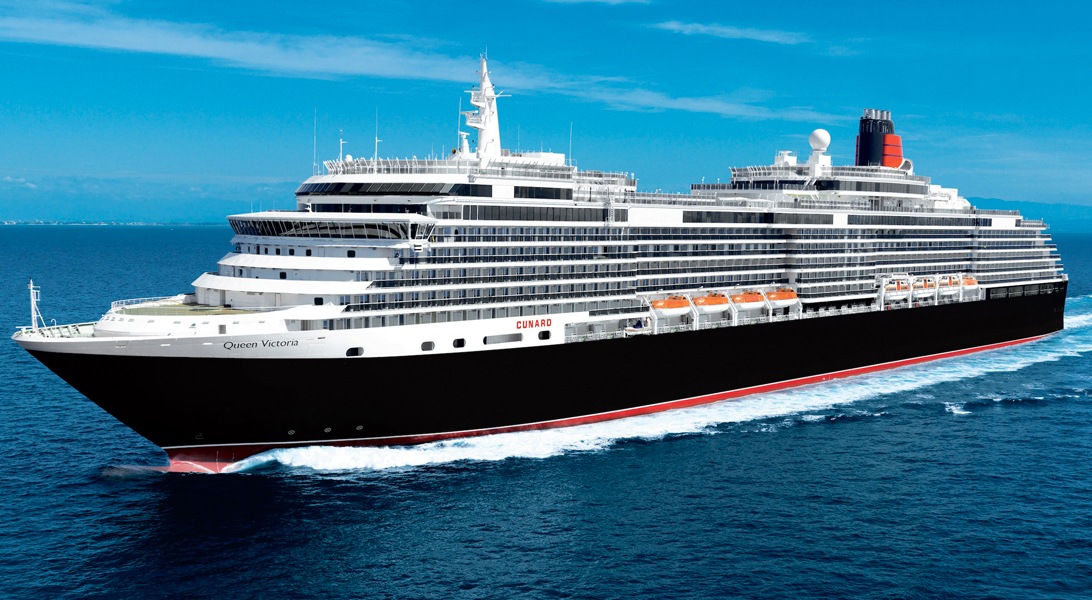












The images shown are for illustration purposes only and may not be an exact representation of what you find on the ship.
The images shown are for illustration purposes only and may not be an exact representation of what you find on the ship.
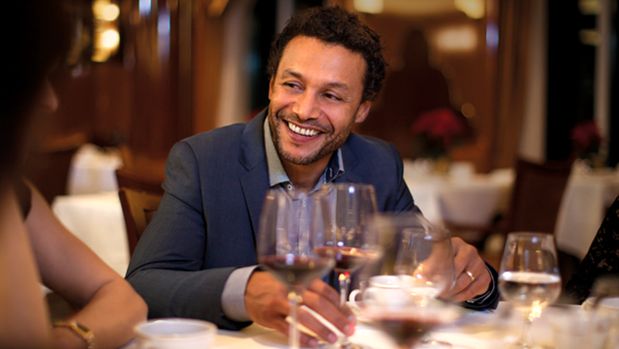
Our main restaurant invites you to enjoy breakfast, lunch and dinner with a real sense of occasion.
Dining is a highlight of each Cunard voyage and the Britannia Restaurant ensures that it's unforgettable, especially on Gala Evenings. Experience a stylish and vibrant atmosphere and be tempted by freshly prepared dishes which range from twists on traditional favourites to contemporary selections. If you decide to join us here for breakfast or lunch you’ll find it traditional and relaxed, whereas at dinner this glamorous venue really sparkles.
Britannia Club guests will appreciate the more intimate surroundings of this stylish restaurant.
As you’d expect, menus change daily and in addition to the full selection from the Britannia restaurant you can savour a range of enhancements for an extraordinary dining experience.
Guests can now choose to reserve a table at any time of the evening alongside the more traditional early and late seating options.
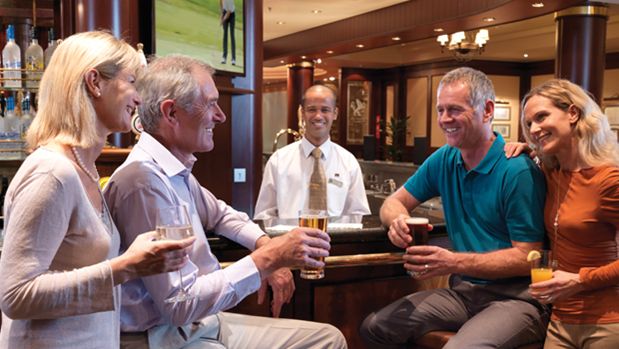
The Golden Lion is an authentic British pub with a great selection of beer and cider. This is complemented by a traditional pub lunch menu with favourites such as cottage pie and fish and chips
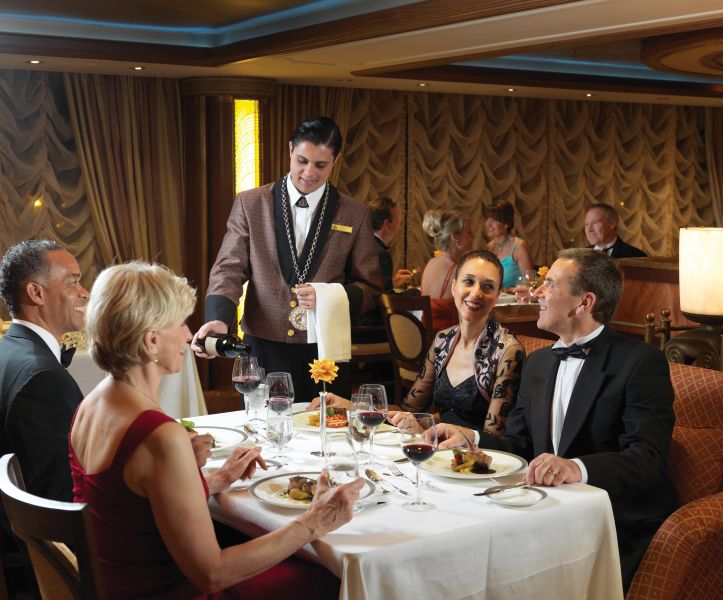
As a Princess Grill guest dining here you’ll appreciate style and elegance, whatever the occasion.
As a guest in our Princess Grill suites you may choose to join us in the elegant Princess Grill for breakfast, lunch or dinner. Whatever the occasion you’ll always feel special with personal and intuitive service. Join us for dinner anytime from 6.30 to 9.00, whenever suits you best.
Choose from dishes such as Goats Cheese Souffle or Yellow Fin Tuna Tartare to start, perhaps followed by Rack of Dartmoor Lamb or Pan Roasted Halibut, all rounded off with a delicious Chocolate Pecan Terrine.
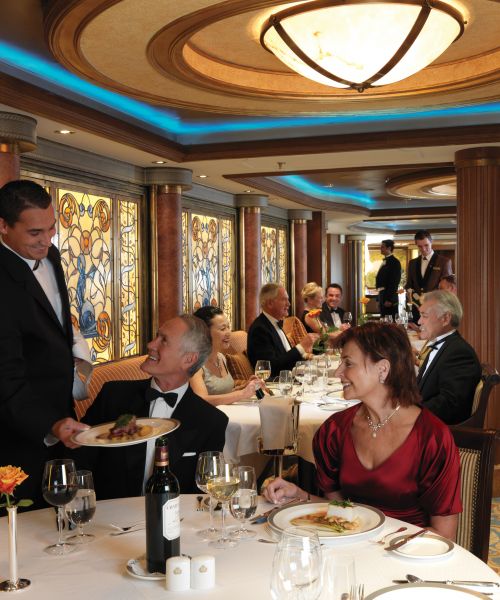
In the beautifully appointed Queens Grill you can savour the ultimate in dining sophistication.
As a guest in our Queens Grill suites you’ll enjoy a remarkable dining experience. Whether it’s for breakfast, lunch or dinner you’ll savour flawless service and impeccably prepared dishes ranging from exquisite contemporary creations to Cunard Classics. Enjoy the daily menu or go A La Carte, you choose. This evening you may relish a Terrine of Kentish Goats Cheese or Devon Crab Cannelloni, followed by Wild Atlantic Turbot or Onley Grounds Chateaubriand, rounded off with Grand Marnier Souffle.
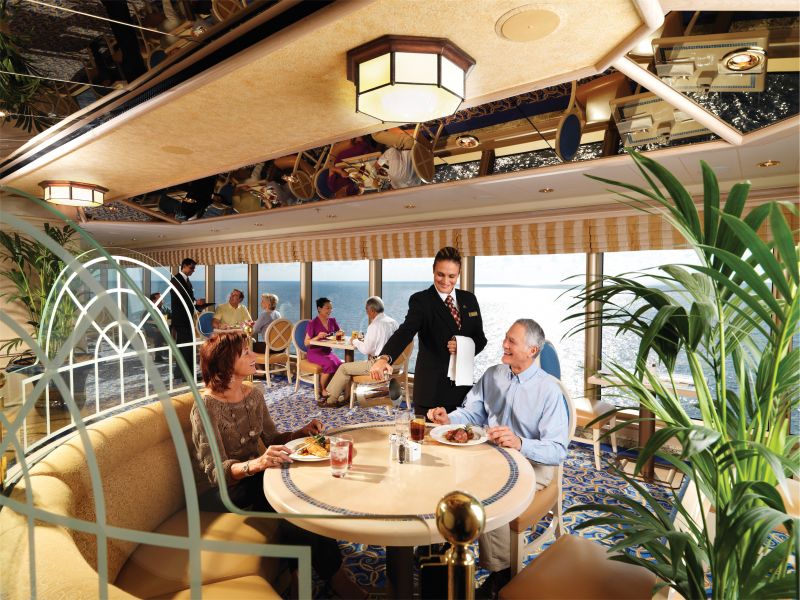
Should you prefer a club sandwich or a light bite in the afternoon head for the Lido restaurant where buffet dining is available throughout the day. By evening it transforms into one of Cunard's regional venues: Asado is a South American Grill; Jasmine serves up exquisite Asian cuisine; while Aztec tempts you with interpretations of Mexican classics.
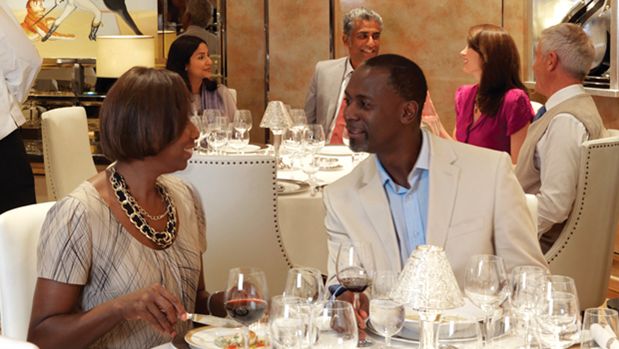
The Verandah is Queen Victoria's formal alternative dining venue and is your invitation to savour contemporary French cuisine that uses traditional ingredients sourced directly from France.
The images shown are for illustration purposes only and may not be an exact representation of what you find on the ship.
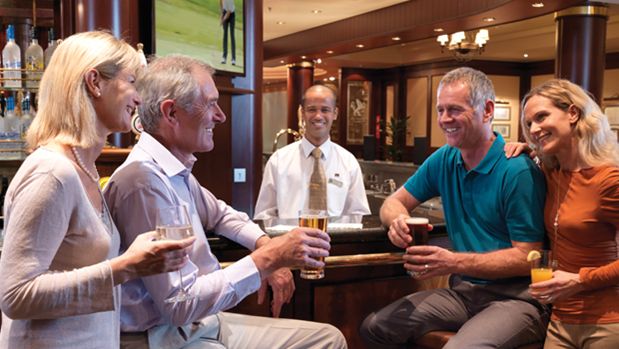
Enjoy the unique atmosphere of a real pub with great beers, scrumptious lunches, live sport and pub games.
A popular venue on each member of the Cunard fleet, the Golden Lion is a warm, inviting space for a daytime brew, a hearty lunch, or an evening pub quiz.
Choose a pub classic from the food menu - included at no extra cost as one of your dining options - and wash it down with one of the Golden Lion's thirst-quenching range of ales, lagers and ciders, including a range of drinks exclusive to Cunard.
Relax in our comfortable booths with your chosen beverage and watch the world sail by. Challenge yourself and your travelling companions with a game of darts, join one of our regular pub quizzes or visit for an after-dinner drink and karaoke.
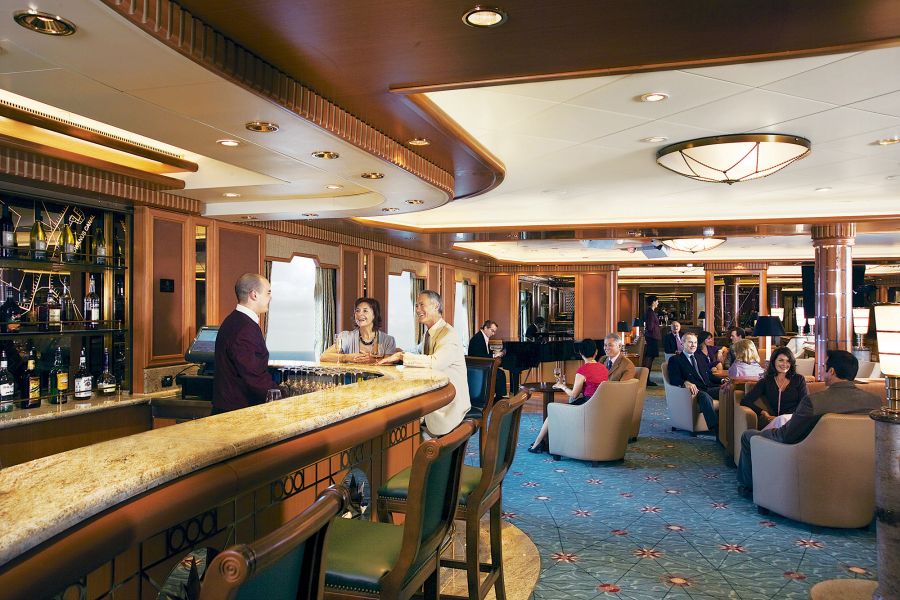
Churchill's Cigar Lounge is located on deck 10.
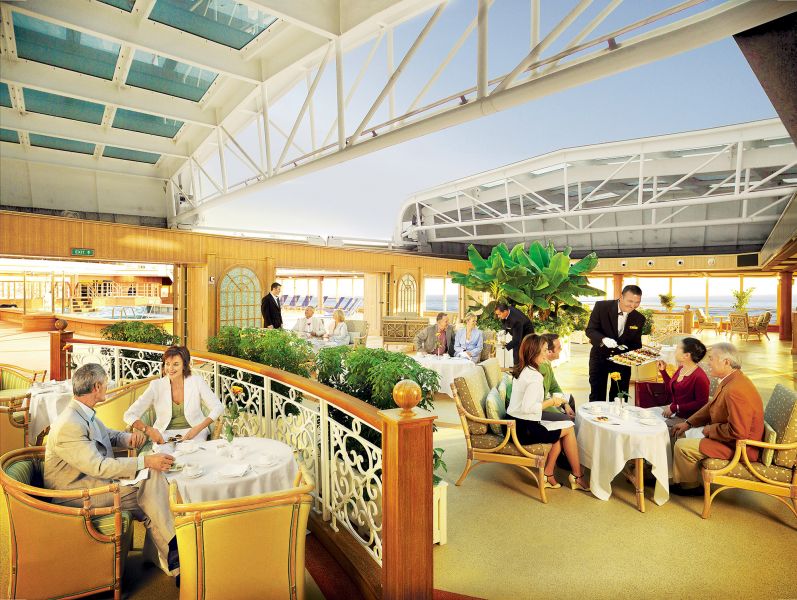
You'll find this airy lounge is flooded with daylight and is always relaxing at any time of day.
On board Queen Victoria, close to the pool and Lido buffet, this is the place to experience a more informal atmosphere until late in the evening. Floor-to-ceiling windows allow sweeping views from this comfortable and relaxing venue.
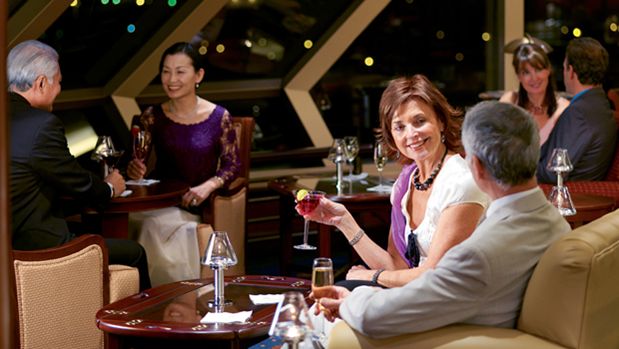
Succumb to the charms of this magical bar, which takes pride of place overlooking the bow of the ship.
Savour the view of the world as it unfurls across the bow from this stunning location and discover just why the Commodore Club is such a remarkable venue. Taking inspiration from our Cunard Commodores who have expertly steered the fleet, join us here to enjoy pre dinner cocktails. Admire the sun setting over the sparkling ocean as you relax to the soothing tones of the pianist. Enjoy a delicious signature martini or sample a cocktail inspired by one of our seven most decorated Commodores.
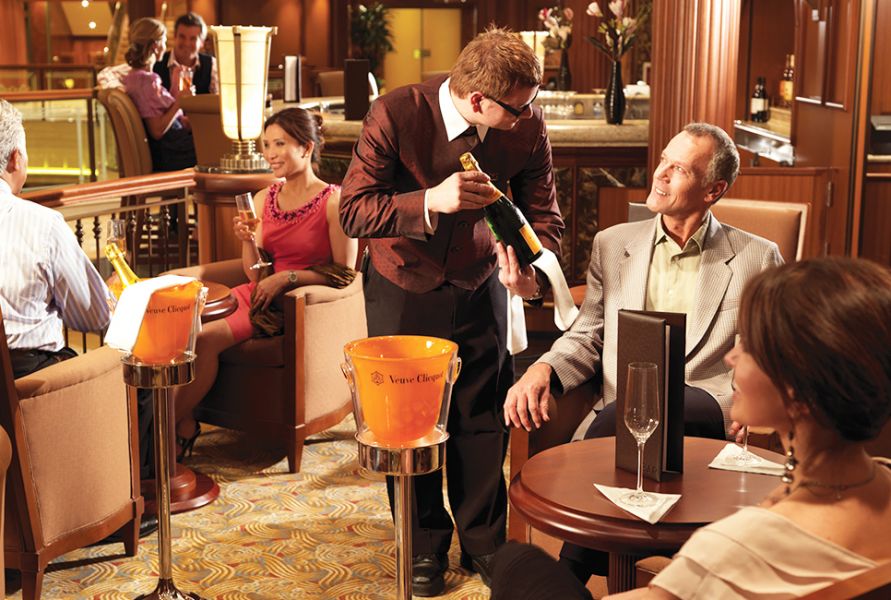
You'll find our elegant Champagne Bar the perfect venue to enjoy delicious premium Champagne.
Cunard is proud to offer guests a comprehensive collection of Laurent-Perrier's premium champagnes across the fleet.
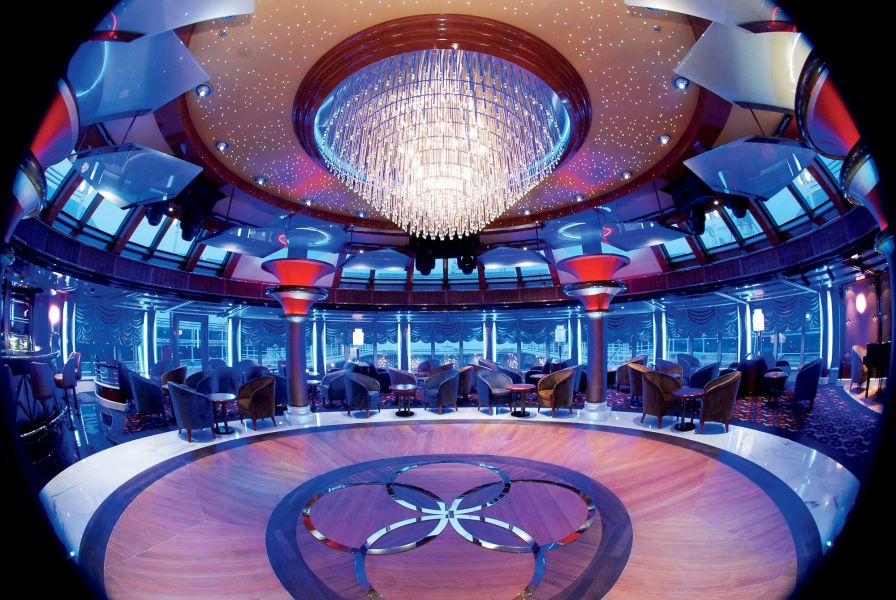
By day admire the expansive panoramic views that stretch from horizon to horizon, and by night dance to the beat of the big band and DJ. All set under the splendid glass-domed roof of this stunning contemporary nightclub.
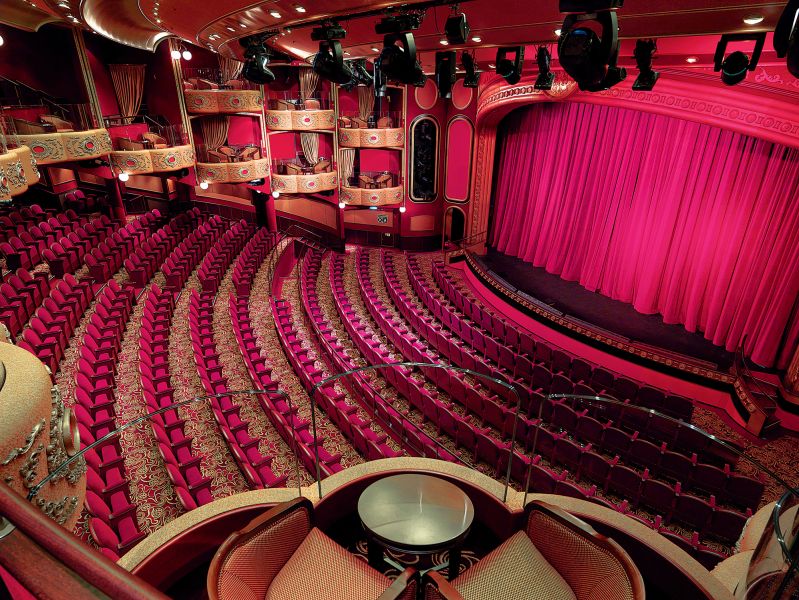
Experience the thrill of a vibrant music and dance extravaganza in our full sized theatres.
You'll find our elegant Royal Court Theatres as impressive as any in the West End or Broadway and they're the perfect setting for you to enjoy invigorating, high-tech dance productions. We're constantly introducing new shows performed by our highly talented Royal Cunard Singers and Dancers. Popular recent productions including the cutting-edge dance shows 'La Danza' and 'Rhythm of the Night,' which takes audiences on a magical journey through the sights and sounds of Latin America.
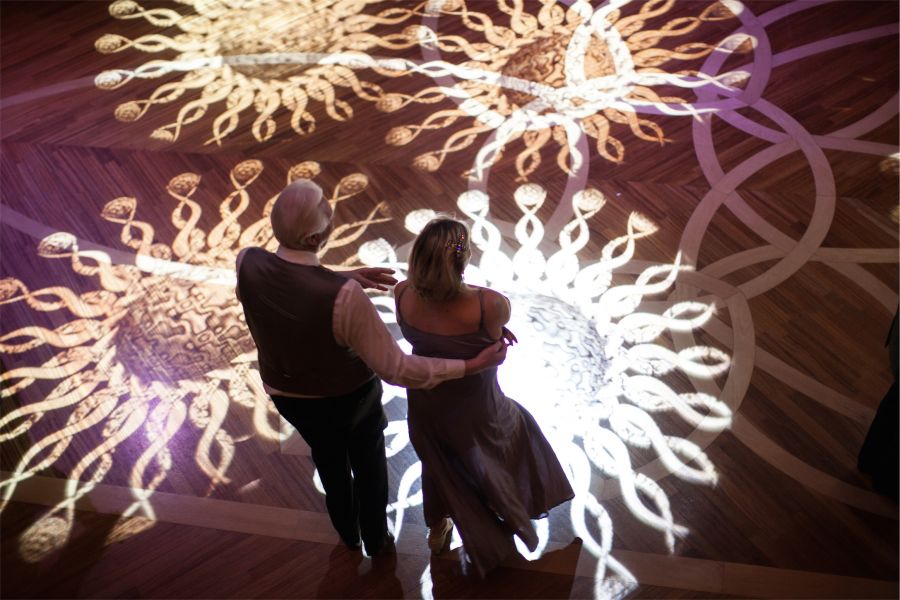
Experience the grandeur of the largest ballroom at sea and the social hub of the ship.
You'll soon discover that it’s the elegant Queens Room which plays centre stage to so much of your social calendar and is frequently a hub of activity. By day this stunning venue hosts dancing classes, fencing, music recitals and our grandest interpretation of Afternoon Tea. When darkness falls join us as the orchestra strikes up for an evening of dancing or simply to enjoy the atmosphere over a cocktail. And it's on Gala Evenings when you'll really love the sparkling sense of occasion here.
The images shown are for illustration purposes only and may not be an exact representation of what you find on the ship.

Teenagers 13 to 17 will have a great time with the sports, discos and games we run around the ship.
Teens in your party will have a whale of a time in this dedicated club for 13 to 17 year-olds. They can enjoy deck sports, discos, gaming consoles, quizzes and much more - ensuring an action-packed holiday. They'll also appreciate the special Teen Zone area where they can challenge each other to the latest video games as well as the table tennis tournaments and team games we organise. Note that the exact age groupings will depend on the number of children travelling on any particular voyage.
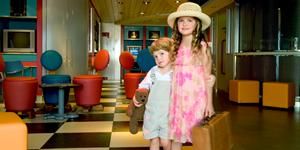
Enjoy your holiday even more, knowing that your little ones have a safe place to sleep each evening.
There's a great sense of freedom to be had when you can enjoy drinks, dinner or a show knowing that your little ones are sleeping soundly. Available on a first come first served basis, our free of charge Night Nursery equips you with a pager so we can contact you if need be or, if you let us know your plans, we'll come and find you. For that extra peace of mind professional childminders are on hand. Suitable for children aged 6 to 23 months and open from 6pm to 11pm.
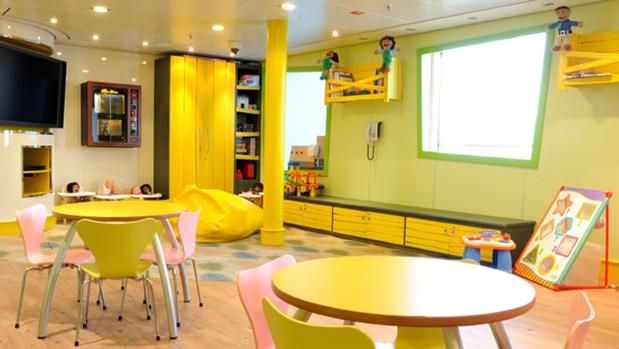
Children aged 2 to 7 will love the activities and themed days in this supervised haven.
The Play Zone is a fully supervised play area which younger members of your family will just love. They're sure to have a fun-filled holiday with the structured activities provided by our fully trained Youth Team - including themed days, arts and crafts, games, books, puzzles, toys and computer games. There's even a sheltered outdoor play area with a range of play equipment such as cars and tricycles. Infants from 6 months to 23 months are welcome to join in the fun, with parental supervision.
The images shown are for illustration purposes only and may not be an exact representation of what you find on the ship.
| Return flights including luggage allowance | |||
| Overseas Transfers | |||
| 52 nights aboard the Queen Victoria | |||
| Choose FREE on-board spend, coach transfers or car parking (Cunard Fares only) | |||
| Complimentary daily afternoon tea | |||
| Evening entertainment & Broadway style shows | |||
| Upgrade to the Grills Experience | |||
| Tea, coffee, fruit juice is available 24 hours | |||
| 24-hour room service | |||
| Port Taxes and Fees | |||
 | ABTA and ATOL Protection* | ||
Fly/cruise package |
Date 21st Jan 2025 |
Nts 52 |
Interior  |
Oceanview  |
Balcony  |
Suite £87,209pp |
Interior  |
Oceanview  |
Balcony  |
Suite £88,209pp |
Date 21st Jan 2025 |
Nts 52 |
Interior  |
Oceanview  |
Balcony  |
Suite £87,209pp |
Interior  |
Oceanview  |
Balcony  |
Suite £88,209pp |






| Interior staterooms |  | ||
| LC | Single Inside |  | |
| GA | Deluxe Inside |  | |
| GB | Deluxe Inside |  | |
| GC | Deluxe Inside |  | |
| IA | Standard Inside |  | |
| ID | Standard Inside |  | |
| IE | Standard Inside |  | |
| IF | Standard Inside |  | |
| Oceanview staterooms |  | ||
| KC | Single Oceanview |  | |
| EB | Oceanview |  | |
| EC | Oceanview |  | |
| EF | Oceanview |  | |
| FB | Oceanview |  | |
| FC | Oceanview |  | |
| Balcony staterooms |  | ||
| A1 | Club Balcony |  | |
| A2 | Club Balcony |  | |
| BA | Balcony |  | |
| BB | Balcony |  | |
| BC | Balcony |  | |
| BD | Balcony |  | |
| BE | Balcony |  | |
| BF | Balcony |  | |
| CA | Balcony |  | |
| CB | Balcony |  | |
| Suite staterooms from | £87,209pp | ||
| P1 | Princess Suite |  | |
| P2 | Princess Suite |  | |
| Q1 | Grand Suite | £87,209pp | |
| Q2 | Master Suite |  | |
| Q3 | Penthouse |  | |
| Q4 | Penthouse |  | |
| Q5 | Queens Suite |  | |
| Q6 | Queens Suite |  | |
| Interior staterooms |  | ||
| LC | Single Inside |  | |
| GA | Deluxe Inside |  | |
| GB | Deluxe Inside |  | |
| GC | Deluxe Inside |  | |
| IA | Standard Inside |  | |
| ID | Standard Inside |  | |
| IE | Standard Inside |  | |
| IF | Standard Inside |  | |
| Oceanview staterooms |  | ||
| KC | Single Oceanview |  | |
| EB | Oceanview |  | |
| EC | Oceanview |  | |
| EF | Oceanview |  | |
| FB | Oceanview |  | |
| FC | Oceanview |  | |
| Balcony staterooms |  | ||
| A1 | Club Balcony |  | |
| A2 | Club Balcony |  | |
| BA | Balcony |  | |
| BB | Balcony |  | |
| BC | Balcony |  | |
| BD | Balcony |  | |
| BE | Balcony |  | |
| BF | Balcony |  | |
| CA | Balcony |  | |
| CB | Balcony |  | |
| Suite staterooms from | £88,209pp | ||
| P1 | Princess Suite |  | |
| P2 | Princess Suite |  | |
| Q1 | Grand Suite | £88,209pp | |
| Q2 | Master Suite |  | |
| Q3 | Penthouse |  | |
| Q4 | Penthouse |  | |
| Q5 | Queens Suite |  | |
| Q6 | Queens Suite |  | |
Cunard Fare Benefits
Choice of stateroom ~ First priority dining ~ First priority upgrades ~ Choice of on-board spending money*, car parking* or return coach travel* ~ Low Deposit ~ Flexibility to change your booking ~ Complimentary shuttle buses in port (where available). T&C’s apply
*Not available on cruises less than 5 nights
| Interior staterooms |  | ||
| LC | Single Inside |  | |
| LC | Single Inside |  | |
| GA | Deluxe Inside |  | |
| GA | Deluxe Inside |  | |
| GB | Deluxe Inside |  | |
| GB | Deluxe Inside |  | |
| GC | Deluxe Inside |  | |
| GC | Deluxe Inside |  | |
| IA | Standard Inside |  | |
| IA | Standard Inside |  | |
| ID | Standard Inside |  | |
| ID | Standard Inside |  | |
| IE | Standard Inside |  | |
| IE | Standard Inside |  | |
| IF | Standard Inside |  | |
| IF | Standard Inside |  | |
| Oceanview staterooms |  | ||
| KC | Single Oceanview |  | |
| KC | Single Oceanview |  | |
| EB | Oceanview |  | |
| EB | Oceanview |  | |
| EC | Oceanview |  | |
| EC | Oceanview |  | |
| EF | Oceanview |  | |
| EF | Oceanview |  | |
| FB | Oceanview |  | |
| FB | Oceanview |  | |
| FC | Oceanview |  | |
| FC | Oceanview |  | |
| Balcony staterooms |  | ||
| A1 | Club Balcony |  | |
| A1 | Club Balcony |  | |
| A2 | Club Balcony |  | |
| A2 | Club Balcony |  | |
| BA | Balcony |  | |
| BA | Balcony |  | |
| BB | Balcony |  | |
| BB | Balcony |  | |
| BC | Balcony |  | |
| BC | Balcony |  | |
| BD | Balcony |  | |
| BD | Balcony |  | |
| BE | Balcony |  | |
| BE | Balcony |  | |
| BF | Balcony |  | |
| BF | Balcony |  | |
| CA | Balcony |  | |
| CA | Balcony |  | |
| CB | Balcony |  | |
| CB | Balcony |  | |
| Suite staterooms from | £87,209pp | ||
| P1 | Princess Suite |  | |
| P1 | Princess Suite |  | |
| P2 | Princess Suite |  | |
| P2 | Princess Suite |  | |
| Q1 | Grand Suite | £87,209pp | |
| Q1 | Grand Suite | £87,209pp | |
| Q2 | Master Suite |  | |
| Q2 | Master Suite |  | |
| Q3 | Penthouse |  | |
| Q3 | Penthouse |  | |
| Q4 | Penthouse |  | |
| Q4 | Penthouse |  | |
| Q5 | Queens Suite |  | |
| Q5 | Queens Suite |  | |
| Q6 | Queens Suite |  | |
| Q6 | Queens Suite |  | |
| Interior staterooms |  | ||
| LC | Single Inside |  | |
| GA | Deluxe Inside |  | |
| GB | Deluxe Inside |  | |
| GC | Deluxe Inside |  | |
| IA | Standard Inside |  | |
| ID | Standard Inside |  | |
| IE | Standard Inside |  | |
| IF | Standard Inside |  | |
| Oceanview staterooms |  | ||
| KC | Single Oceanview |  | |
| EB | Oceanview |  | |
| EC | Oceanview |  | |
| EF | Oceanview |  | |
| FB | Oceanview |  | |
| FC | Oceanview |  | |
| Balcony staterooms |  | ||
| A1 | Club Balcony |  | |
| A2 | Club Balcony |  | |
| BA | Balcony |  | |
| BB | Balcony |  | |
| BC | Balcony |  | |
| BD | Balcony |  | |
| BE | Balcony |  | |
| BF | Balcony |  | |
| CA | Balcony |  | |
| CB | Balcony |  | |
| Suite staterooms from | £88,209pp | ||
| P1 | Princess Suite |  | |
| P2 | Princess Suite |  | |
| Q1 | Grand Suite | £88,209pp | |
| Q2 | Master Suite |  | |
| Q3 | Penthouse |  | |
| Q4 | Penthouse |  | |
| Q5 | Queens Suite |  | |
| Q6 | Queens Suite |  | |
Fusion Cruises when selling travel arrangements is a trading name of The Midcounties Co-operative Ltd. Fusion Cruises is an Accredited Body Member of Midcounties Co-operative Travel Consortium. (ABTA:P6652, ATOL:6053).
Book with Confidence. We are a Member of ABTA which means you have the benefit of ABTA’s assistance and Code of Conduct.
Some of the flights and flight-inclusive holidays on this website are financially protected by the ATOL scheme but ATOL protection does not apply to all holiday and travel services offered on this website. This website will provide you with information on the protection that applies in the case of each holiday and travel service offered before you make your booking. If you do not receive an ATOL Certificate then the booking will not be ATOL protected. If you do receive an ATOL Certificate but all parts of your trip are not listed on it, those parts will not be ATOL protected. Please see our booking conditions for information, or for more information about financial protection and the ATOL Certificate go to: www.caa.co.uk
